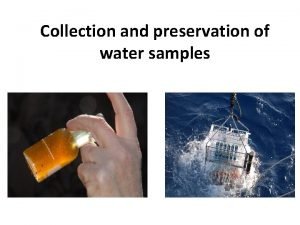Mechanical Engineering Project Water Collection System MATTHEW ERNST













- Slides: 13

Mechanical Engineering Project Water Collection System MATTHEW ERNST METC 107 FALL 2017

How a Water Collection System Works Rainwater recycling involves collecting and reusing rainwater from a building’s roof or any other surface The rainwater must pass through a filter, eliminating debris The remaining water is then held in a storage tank, either underground or on the side of a building This saved water can be pumped into places where it may be needed (bathroom, kitchen, laundry room, etc. )

How a Water Collection System Works cont. The rainwater collected by most of these harvesting systems is usually not drinkable without substantial treatment For safety measures, it is important that the collected rainwater be passed through a dedicated piping system and not the building’s drinking system Most systems involve: Holding tank-hold the water Control unit-monitor the level of water in the tank Filter-stops debris Separate pipe system

Cost of Water Collection System A do-it-yourself rain barrel system typically costs between $20 -$50 Prefabricated rain barrels cost $70 -$300 depending on size and capacity A cistern is a water storage container made of metal, fiberglass, polyethylene (plastic), concrete, or wood, and can vary in cost depending on size and capacity 150 -350 gallons: $150 -$650 500 -10, 000 gallons: $500 -$10, 000 Installation costs vary from $2, 000 -$20, 000 or more depending on size, capacity, and various functions

Cost of Water Collection System cont. A dry well is an underground structure designed to allow water to percolate into the water table (upper surface of zone of saturation) A do-it-yourself dry well will cost $5 -$50, whereas a prefabricated plastic dry well will cost around $90 -$350 Installation of a dry well with all materials costs $300 -$5, 000

Disadvantages of a Water Collection System Rainfall is hard to predict and it is not advised to depend on rainwater alone, especially for people who live in areas of little rainfall A rainwater collection system may cost anywhere from $200 -$2, 000 depending on size and technology level and benefit cannot be derived until it is ready for use; cost recovers in 10 -15 years depending on rainfall and sophistication of system Water collection systems require regular maintenance in order to protect them from rodents, mosquitoes, algae growth, insects, etc. Certain roof types may seep insects, dirt, or chemicals Collection and storage facilities may limit the capacity of usable water; downpour water may escape; does not equal unlimited water supply

Auto. CAD Drawings

Auto. CAD Drawings cont. First flush diverter Floating intake

Auto. CAD Drawings cont.

Auto. CAD Drawings cont.

Auto. CAD Drawings cont.

Auto. CAD Drawings Cont.

Sources https: //www. renewableenergyhub. us/rainwater-harvesting-information/howdoes-rainwater-recycling-work. html http: //home. costhelper. com/rain-harvesting. html https: //www. conserve-energyfuture. com/advantages_disadvantages_rainwater_harvesting. php
 Water and water and water water
Water and water and water water Landsat collection 1 vs collection 2
Landsat collection 1 vs collection 2 Documentary payment
Documentary payment Clil water
Clil water Actual mechanical advantage vs ideal mechanical advantage
Actual mechanical advantage vs ideal mechanical advantage Computer based system engineering in software engineering
Computer based system engineering in software engineering How to make a water filtration system for a school project
How to make a water filtration system for a school project Types of water sample
Types of water sample Biotic community is another name for____
Biotic community is another name for____ Ernst haeckel tree of life
Ernst haeckel tree of life Ernst haeckel ecology
Ernst haeckel ecology Fuchskirche thal
Fuchskirche thal Max ernst forest and dove
Max ernst forest and dove Que es frotage
Que es frotage
























